|
2001
Finn
Forum VI — Jyväskylä


 My prime activity for
the year 2001 was attending the
academic conference Finn
Forum at the University of Jyväskylä in
Finland from June 13 to 16. Chaired by
Dr. Olavi Koivukangas. Director of
the Migration Institute in Turku,
the
conference drew 27 academics from
Finland, United States, Canada.
and Australia
to lecture on the theme: ‘Entering
Multiculturalism: Finnish
Experience Abroad.”
Subjects included the
Finnish emigre experience in the
1930s Soviet Karelia,
Finnish migrant women, gender
expressions of ethnicity of
Finnish-Americans,
Finnish-American
cranberry farming on Cape Cod, a
documentary film about the
Finnish cooperative community of
Sointula, BC,
Finns in Australia, and the story
of a Finnish-American
Russian spy. I had attended Finn
Forum II in Toronto on
1979, also a profound learning
experience on my own Finnish
roots. My prime activity for
the year 2001 was attending the
academic conference Finn
Forum at the University of Jyväskylä in
Finland from June 13 to 16. Chaired by
Dr. Olavi Koivukangas. Director of
the Migration Institute in Turku,
the
conference drew 27 academics from
Finland, United States, Canada.
and Australia
to lecture on the theme: ‘Entering
Multiculturalism: Finnish
Experience Abroad.”
Subjects included the
Finnish emigre experience in the
1930s Soviet Karelia,
Finnish migrant women, gender
expressions of ethnicity of
Finnish-Americans,
Finnish-American
cranberry farming on Cape Cod, a
documentary film about the
Finnish cooperative community of
Sointula, BC,
Finns in Australia, and the story
of a Finnish-American
Russian spy. I had attended Finn
Forum II in Toronto on
1979, also a profound learning
experience on my own Finnish
roots.
Kaarlo R.
Tuomi, Finnish-American
Russian Spy
|
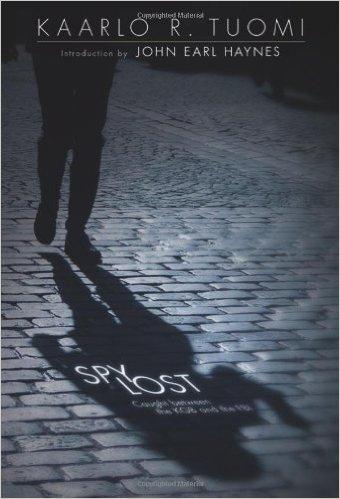
|
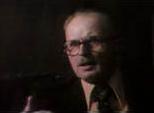
|
| Kaarlo Tuomi |
|
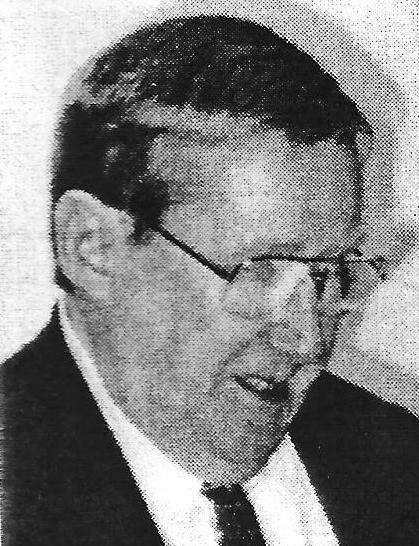
|
|
Michael G.
Karni, PhD
|
 Focus of
this essay is the
story of Kaarlo R. Tuomi, a
Finnish-American
Russian
spy and Cold War double agent, a
lecture given by the late Michael
G. Karni, PhD
(1941–2002) at
Jyväskylä. Mike was
an old friend, a free lance
Finnish-American
scholar I had heard lecture on a variety of
subjects beginning with Finn Forum
II
in Toronto in 1979. Frequently,
his FinnFest topics were about the
history of the
Finnish-American
cooperative movement. He was
editor of the magazine Finnish-Americana
and
founder of the Sampo Publishing Company,
publisher of English
language books on Finnish-American
history and culture. I had
appeared with
Mike on a panel at the 2000 Finn
GrandFest in Toronto on “Karelian
Fever: The
Survivors,” along with Dr. Alexis
Pogorelskin and Rudy Pinola,
moderated by
Anita Hokkanen Middleton, who had
produced a documentary film, “The
Suvivors: North American Finns in
Stalin’s Russia.” Unfortunately,
Mike died
prematurely at age 60 in 2002. Focus of
this essay is the
story of Kaarlo R. Tuomi, a
Finnish-American
Russian
spy and Cold War double agent, a
lecture given by the late Michael
G. Karni, PhD
(1941–2002) at
Jyväskylä. Mike was
an old friend, a free lance
Finnish-American
scholar I had heard lecture on a variety of
subjects beginning with Finn Forum
II
in Toronto in 1979. Frequently,
his FinnFest topics were about the
history of the
Finnish-American
cooperative movement. He was
editor of the magazine Finnish-Americana
and
founder of the Sampo Publishing Company,
publisher of English
language books on Finnish-American
history and culture. I had
appeared with
Mike on a panel at the 2000 Finn
GrandFest in Toronto on “Karelian
Fever: The
Survivors,” along with Dr. Alexis
Pogorelskin and Rudy Pinola,
moderated by
Anita Hokkanen Middleton, who had
produced a documentary film, “The
Suvivors: North American Finns in
Stalin’s Russia.” Unfortunately,
Mike died
prematurely at age 60 in 2002.

 Kaarlo R.
Tuomi, was born on Nov. 30, 1916, to a
leftist Finnish immigrant family
in Rock, on Michigan’s Upper
Peninsula. While still a high
school student in Rock
at the height of the great
Depression in 1933, his embittered
unemployed
stepfather Robert Saastamoinen, a
Communist Party member, decided to
move his
family to Soviet Karelia whose
recruiters promised plenty of work
and a good life.
With his American education ended,
Kaarlo found work in the forests
of Uhtua in
Karelia where in a couple of years
he became a journeyman lumberjack.
Being in a
remote place like Uhtua and his
young age. Kaarlo escaped the
Stalinist purges of
hundreds of his older North
American Finnish comrades in
Karelia in 1937–38. In
1940, he was drafted into the Red
Army and fought on the Finnish
front during the
Continuation War
from 1941–44. After
his discharge he went to school on
a
Soviet sort of GI Bill, and he
became an English language
teacher. During that
period Tuomi married a Russian
woman who bore him three children.
But by the
mid-1950s, the Soviet system had other
plans for him. Because of his
command of
American English from the land of
his birth and still the holder of
a US passport,
he was a prime target to be
trained as a spy for the KGB to be
groomed to work in
America. After some pressure and
as still a loyal
Communist, he agreed to the
proposition. Kaarlo R.
Tuomi, was born on Nov. 30, 1916, to a
leftist Finnish immigrant family
in Rock, on Michigan’s Upper
Peninsula. While still a high
school student in Rock
at the height of the great
Depression in 1933, his embittered
unemployed
stepfather Robert Saastamoinen, a
Communist Party member, decided to
move his
family to Soviet Karelia whose
recruiters promised plenty of work
and a good life.
With his American education ended,
Kaarlo found work in the forests
of Uhtua in
Karelia where in a couple of years
he became a journeyman lumberjack.
Being in a
remote place like Uhtua and his
young age. Kaarlo escaped the
Stalinist purges of
hundreds of his older North
American Finnish comrades in
Karelia in 1937–38. In
1940, he was drafted into the Red
Army and fought on the Finnish
front during the
Continuation War
from 1941–44. After
his discharge he went to school on
a
Soviet sort of GI Bill, and he
became an English language
teacher. During that
period Tuomi married a Russian
woman who bore him three children.
But by the
mid-1950s, the Soviet system had other
plans for him. Because of his
command of
American English from the land of
his birth and still the holder of
a US passport,
he was a prime target to be
trained as a spy for the KGB to be
groomed to work in
America. After some pressure and
as still a loyal
Communist, he agreed to the
proposition.
 So for the
next three years Tuomi was
schooled in the arts and crafts of
becoming
a KGB spy. He learned to process
and plant microfilm messages, an
essential tool.
But most importantly he had to be
convincing as a
genuine lifelong Finnish-American,
besides being further
indoctrinated in Russian politics
and Communist
ideology to reinforce his loyalty
to the Soviet Union. He was sent
several times to
Finland to develop his image as a
genuine Finnish-American businessman
all the
way to dress and grooming. This
Americanization of Kaarlo was
further enhanced
by trips to other Western European
capitals. All this time he was
being paid
enough to support his family and
was even rewarded with a new
washing machine. So for the
next three years Tuomi was
schooled in the arts and crafts of
becoming
a KGB spy. He learned to process
and plant microfilm messages, an
essential tool.
But most importantly he had to be
convincing as a
genuine lifelong Finnish-American,
besides being further
indoctrinated in Russian politics
and Communist
ideology to reinforce his loyalty
to the Soviet Union. He was sent
several times to
Finland to develop his image as a
genuine Finnish-American businessman
all the
way to dress and grooming. This
Americanization of Kaarlo was
further enhanced
by trips to other Western European
capitals. All this time he was
being paid
enough to support his family and
was even rewarded with a new
washing machine.
 Finally.
the KGB dispatched Tuomi for
assignment in the United States in
1959.
But shortly after his arrival, he
was arrested in Superior, WI by
the FBI and taken
to a lakeside cabin for
questioning. They appeared to know
the smallest details
about his life both
in the United States and Soviet
Union, undoubtedly established
by US secret agents. After five
days of intense interrogation,
Tuomi admitted to
being a KGB agent. They made a
proposition to him, either go to
work for the
United States as a double agent or
spend the next 35 years in Federal
prison. With
no inspiration for martyrdom, he
chose the former course. He
service to the FBI
centered on providing information
on the United States doctored by
the Feds to be
deposited at regular intervals in
a cannister
in a secret hiding place in New
York
for Russian agents to pick up. The
information provided by the FBI
was accurate
enough but was of little
importance to benefit the Soviets,
From the canisters
Tuomi also got money to support
himself although he worked
as a bookkeeper at
Tiffany’s Jewelry in NY. Meantime,
he had fallen in love with a
Finnish-American
widow from Cook, MN living in NY.
So the FBI financed a trip for him
to Mexico
to divorce his Russian wife to
marry her. Finally.
the KGB dispatched Tuomi for
assignment in the United States in
1959.
But shortly after his arrival, he
was arrested in Superior, WI by
the FBI and taken
to a lakeside cabin for
questioning. They appeared to know
the smallest details
about his life both
in the United States and Soviet
Union, undoubtedly established
by US secret agents. After five
days of intense interrogation,
Tuomi admitted to
being a KGB agent. They made a
proposition to him, either go to
work for the
United States as a double agent or
spend the next 35 years in Federal
prison. With
no inspiration for martyrdom, he
chose the former course. He
service to the FBI
centered on providing information
on the United States doctored by
the Feds to be
deposited at regular intervals in
a cannister
in a secret hiding place in New
York
for Russian agents to pick up. The
information provided by the FBI
was accurate
enough but was of little
importance to benefit the Soviets,
From the canisters
Tuomi also got money to support
himself although he worked
as a bookkeeper at
Tiffany’s Jewelry in NY. Meantime,
he had fallen in love with a
Finnish-American
widow from Cook, MN living in NY.
So the FBI financed a trip for him
to Mexico
to divorce his Russian wife to
marry her.
 This
charade kept up until 1962,
when after the Cuban missile
crisis, the Soviets
ordered all its foreign agents to
return to Russia. Tuomi had a
panic attack and
asked the FBI for asylum as he was
unsure what his Russian bosses
knew about
him. The Feds offered him a new
identity and job as
his career as a double agent
was over. But he preferred to keep
his old name and contact with the
Finnish-American
community of his birth. So at that
point since the KGB did not hear
further from him he was considered
a “non-person” in
his homeland of 25
years.
He then moved to Cook, MN with his
new bride to live a quiet life of
anonymity.
But that was not to be. In 1970
Readers’ Digest wrote a two-part
article on
Tuomi’s double
life as a spy. So with all this
unsolicited publicity, he made the
most of it by arranging a
national speaking tour at hundreds
of public meetings to
cash in on his notoriety. Now the
USSR could brand him as an “enemy
of the
state.” He even wrote an
unpublished manuscript of this
aspect of his life for
which he sought ghostwriters.
He fired two of them and was
turned down for that
chore by a prolific author of
critical texts on Communism, Dr.
John E. Haynes.
Finally in 1984, Werner Söderström
Publishers of Finland published a
Finnish
language book on his political
life with the
English title of “The Story of a
Man
Without a Country: The Memoirs of
a Finnish-American
Spy.” A paperback
account appeared in 2114: “Spy
Lost, Caught Between the KGB and
FBI,” with an
introduction by John Earl Haynes.
A spy is not the most popular or
enviable figure
in political life, particularly a
double agent. It ends up
frequently in chaotic and
bizarre personality traits for
such parties involved. This was
true of Kaarlo Tuomi,
truly a man without a country who
really belonged nowhere. Dr. Haynes, who
knew him well, talked of his
anger, rage, and paranoia and mood
swings of a
conflicted personality. I only met
him twice to talk to him, at the
second Hancock
FinnFest in 1985 and at the
Florida FinnFest of 1991, and
didn’t feel comfortable
around him.
Probably Mike Karni who wrote and
lectured about him may have felt
differently. The late Reino
Hannula, publisher of Finn
Heritage magazine, saw him
as a genuine patriot for asserting
his loyalty to the United States
after abandoning
his earlier commitment
to the closed society of the USSR.
I saw him as something
of a tormented personality who did
not come across as a happy camper
to me. His
emotional scars always seemed to
remain livid. Kaarlo R. Tuomi died
at 78 in
Lake Worth, Florida in 1995. This
charade kept up until 1962,
when after the Cuban missile
crisis, the Soviets
ordered all its foreign agents to
return to Russia. Tuomi had a
panic attack and
asked the FBI for asylum as he was
unsure what his Russian bosses
knew about
him. The Feds offered him a new
identity and job as
his career as a double agent
was over. But he preferred to keep
his old name and contact with the
Finnish-American
community of his birth. So at that
point since the KGB did not hear
further from him he was considered
a “non-person” in
his homeland of 25
years.
He then moved to Cook, MN with his
new bride to live a quiet life of
anonymity.
But that was not to be. In 1970
Readers’ Digest wrote a two-part
article on
Tuomi’s double
life as a spy. So with all this
unsolicited publicity, he made the
most of it by arranging a
national speaking tour at hundreds
of public meetings to
cash in on his notoriety. Now the
USSR could brand him as an “enemy
of the
state.” He even wrote an
unpublished manuscript of this
aspect of his life for
which he sought ghostwriters.
He fired two of them and was
turned down for that
chore by a prolific author of
critical texts on Communism, Dr.
John E. Haynes.
Finally in 1984, Werner Söderström
Publishers of Finland published a
Finnish
language book on his political
life with the
English title of “The Story of a
Man
Without a Country: The Memoirs of
a Finnish-American
Spy.” A paperback
account appeared in 2114: “Spy
Lost, Caught Between the KGB and
FBI,” with an
introduction by John Earl Haynes.
A spy is not the most popular or
enviable figure
in political life, particularly a
double agent. It ends up
frequently in chaotic and
bizarre personality traits for
such parties involved. This was
true of Kaarlo Tuomi,
truly a man without a country who
really belonged nowhere. Dr. Haynes, who
knew him well, talked of his
anger, rage, and paranoia and mood
swings of a
conflicted personality. I only met
him twice to talk to him, at the
second Hancock
FinnFest in 1985 and at the
Florida FinnFest of 1991, and
didn’t feel comfortable
around him.
Probably Mike Karni who wrote and
lectured about him may have felt
differently. The late Reino
Hannula, publisher of Finn
Heritage magazine, saw him
as a genuine patriot for asserting
his loyalty to the United States
after abandoning
his earlier commitment
to the closed society of the USSR.
I saw him as something
of a tormented personality who did
not come across as a happy camper
to me. His
emotional scars always seemed to
remain livid. Kaarlo R. Tuomi died
at 78 in
Lake Worth, Florida in 1995.
Nine-Eleven
Terrorism

The Twin Towers and the
Pentagon
|
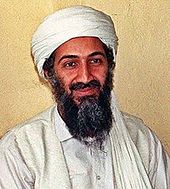
|
|
Osama
bin Laden
|
 I had just
returned home from my 2001 summer
in Finland in early September
when a few days later my
Strawberry Creek Lodge neighbor Al
Benson alarmed
me about the three hijacked planes
which had struck the twin towers
of the World
Trade Center in Manhattan and
the Pentagon culminating in the
deaths of the 19
hijackers as well as nearly 3000
innocent people including cops and
firefighters.
Everybody now knows that the
mastermind for the horror was Al
Qaeda jihadist
Osama Bin Laden, son of a
billionaire Saudi Arabian family,
and a member of the
fanatical Wahhabi cult of
Muslimism that hated the West as
the great Satan whose
people deserved to die. There once
was a prominent Marxist movement
of Arab
Socialism which rationally
analyzed the
imperialist motives of Western
capitalism
to control and profit from the
vast oil resources of the Middle
East. But this
movement had faded into obscurity,
replaced by a holy war of Muslim
fanatics out
to destroy the Infidels and their
Satanic evils. Bin Laden
had been given sanctuary
in Afghanistan by its
fundamentalist Taliban rulers who
were now unwilling to be
the fall guy for him any longer.
The Taliban lost Kabul and other
cities swiftly to
US troops and their Afghan allies
and retreated to their Southern
strongholds. Bin
Laden’s last refuge in the country
was in the rugged mountains around
Tora Tora
in the East but the American
troops chasing him were refused
the additional
reinforcements needed to nail him,
so he and his remaining retinue
were able to
slip across the Pakistan border
into sanctuary for a decade. On
May 1, 2011, a
team of US Navy Seals were
secretly flown to his Pakistan
hideout at night and
killed him. I had just
returned home from my 2001 summer
in Finland in early September
when a few days later my
Strawberry Creek Lodge neighbor Al
Benson alarmed
me about the three hijacked planes
which had struck the twin towers
of the World
Trade Center in Manhattan and
the Pentagon culminating in the
deaths of the 19
hijackers as well as nearly 3000
innocent people including cops and
firefighters.
Everybody now knows that the
mastermind for the horror was Al
Qaeda jihadist
Osama Bin Laden, son of a
billionaire Saudi Arabian family,
and a member of the
fanatical Wahhabi cult of
Muslimism that hated the West as
the great Satan whose
people deserved to die. There once
was a prominent Marxist movement
of Arab
Socialism which rationally
analyzed the
imperialist motives of Western
capitalism
to control and profit from the
vast oil resources of the Middle
East. But this
movement had faded into obscurity,
replaced by a holy war of Muslim
fanatics out
to destroy the Infidels and their
Satanic evils. Bin Laden
had been given sanctuary
in Afghanistan by its
fundamentalist Taliban rulers who
were now unwilling to be
the fall guy for him any longer.
The Taliban lost Kabul and other
cities swiftly to
US troops and their Afghan allies
and retreated to their Southern
strongholds. Bin
Laden’s last refuge in the country
was in the rugged mountains around
Tora Tora
in the East but the American
troops chasing him were refused
the additional
reinforcements needed to nail him,
so he and his remaining retinue
were able to
slip across the Pakistan border
into sanctuary for a decade. On
May 1, 2011, a
team of US Navy Seals were
secretly flown to his Pakistan
hideout at night and
killed him.
2002
George W.
Bush Blames 9-11 on
Iraq
|
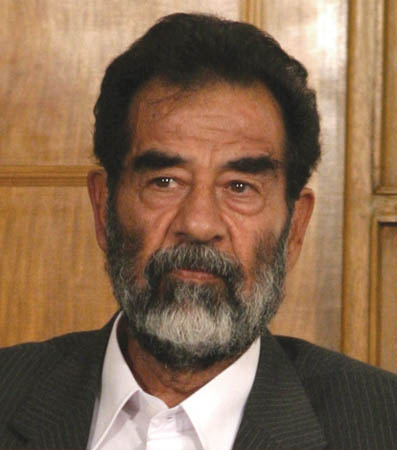
|
|
Saddam
Hussein
|
 President
George W. Bush considered 9-11 as a
conspiracy hatched up between
Saddam Hussein and Osama Bin Laden
and he and his neo-con
advisers, VP Dick
Cheney, Defense Secretary Donald
Rumsfeld and his deputy Paul
Wolfowitz
thought it more important to
finish the job in Iraq his father had failed
to do,
leaving Saddam with a more limited
power after the Gulf War. The
stakes were
much bigger than Bin Laden since
control of the oil resources of
the region were a
priority. So a war to effectuate
regime change in Iraq received top
billing and all
of 2002 was spent in preparing for
war once the leading capitalist
powers of the
West were sufficiently
consolidated to make the war a
success. President
George W. Bush considered 9-11 as a
conspiracy hatched up between
Saddam Hussein and Osama Bin Laden
and he and his neo-con
advisers, VP Dick
Cheney, Defense Secretary Donald
Rumsfeld and his deputy Paul
Wolfowitz
thought it more important to
finish the job in Iraq his father had failed
to do,
leaving Saddam with a more limited
power after the Gulf War. The
stakes were
much bigger than Bin Laden since
control of the oil resources of
the region were a
priority. So a war to effectuate
regime change in Iraq received top
billing and all
of 2002 was spent in preparing for
war once the leading capitalist
powers of the
West were sufficiently
consolidated to make the war a
success.
|
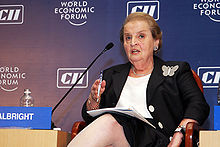
|
|
Defense
Secretary Madeleine Albright
|
 Not that
the Bill Clinton administration
preceding W’s didn’t do its part
to effect
regime change in Iraq. He
never removed the Gulf War
sanctions against the
Saddam regime and though there
were no boots on the ground,
intensive bombing
of the country by the US continued
and because of the economic
sanctions, over a
half million Iraqi children died
of malnutrition and
disease. When Salon magazine
questioned his Defense Secretary
Madeleine Albright whether a half-million
children’s deaths were worth the
price, she coolly responded they
were worth it.
Albright also supported the
argument there were “weapons of mass
destruction” in
Saddam’s possession. Any trace of
such armament was gone since the
1990s,
although it became the Big Lie
perpetuated by the younger Bush’s
regime to start
Gulf War II. So like the old
baseball combination play of
Tinkers to Evers to
Chance, it was now Bush to Clinton
to Bush in a much more lethal
game. Not that
the Bill Clinton administration
preceding W’s didn’t do its part
to effect
regime change in Iraq. He
never removed the Gulf War
sanctions against the
Saddam regime and though there
were no boots on the ground,
intensive bombing
of the country by the US continued
and because of the economic
sanctions, over a
half million Iraqi children died
of malnutrition and
disease. When Salon magazine
questioned his Defense Secretary
Madeleine Albright whether a half-million
children’s deaths were worth the
price, she coolly responded they
were worth it.
Albright also supported the
argument there were “weapons of mass
destruction” in
Saddam’s possession. Any trace of
such armament was gone since the
1990s,
although it became the Big Lie
perpetuated by the younger Bush’s
regime to start
Gulf War II. So like the old
baseball combination play of
Tinkers to Evers to
Chance, it was now Bush to Clinton
to Bush in a much more lethal
game.
CONTINUE
NEXT COLUMN
|
 Bush made
his case to the UN Security
Council for support but the veto
power of
Russia and China precluded that
option. Prez W. commenced to
develop his
“Coalition of the Willing” to make
possible an international force to
pursue the
combat phase. Some 48 countries
became Coalition signatories
although only
three made a significant
contribution to the combat itself:
USA, UK, and Australia.
Some sarcastic comments were heard
over the name of
the Coalition itself.
Columnist Laura McClure of Salon
called it the “Coalition of the
Billing,” British
activist Tariq Ali called it
“Coalition of the Shilling,” and
conservative
Democratic Senator Robert Byrd of
Virginia called it “COW” with the US being
“milked like a cash cow.” Bush made
his case to the UN Security
Council for support but the veto
power of
Russia and China precluded that
option. Prez W. commenced to
develop his
“Coalition of the Willing” to make
possible an international force to
pursue the
combat phase. Some 48 countries
became Coalition signatories
although only
three made a significant
contribution to the combat itself:
USA, UK, and Australia.
Some sarcastic comments were heard
over the name of
the Coalition itself.
Columnist Laura McClure of Salon
called it the “Coalition of the
Billing,” British
activist Tariq Ali called it
“Coalition of the Shilling,” and
conservative
Democratic Senator Robert Byrd of
Virginia called it “COW” with the US being
“milked like a cash cow.”
HUGE ANTIWAR
MOVEMENT DEVELOPS
 As Bush’s
war buildup grew to
attack Iraq all during 2002 it
became obvious that
such a development was not a
question of “if” but “when.” The
global antiwar
movement which played a major role in
bringing an end to the Vietnam War
in the
1970s, was no less prominent in
building a massive resistance
against the
commencement of this one. Huge
demonstrations numbering millions
took place
throughout the latter part of 2002
and in 2003 in many parts of
the world to match
the military buildup by the
so-called “Coalition of the
Willing.” As Bush’s
war buildup grew to
attack Iraq all during 2002 it
became obvious that
such a development was not a
question of “if” but “when.” The
global antiwar
movement which played a major role in
bringing an end to the Vietnam War
in the
1970s, was no less prominent in
building a massive resistance
against the
commencement of this one. Huge
demonstrations numbering millions
took place
throughout the latter part of 2002
and in 2003 in many parts of
the world to match
the military buildup by the
so-called “Coalition of the
Willing.”
2003
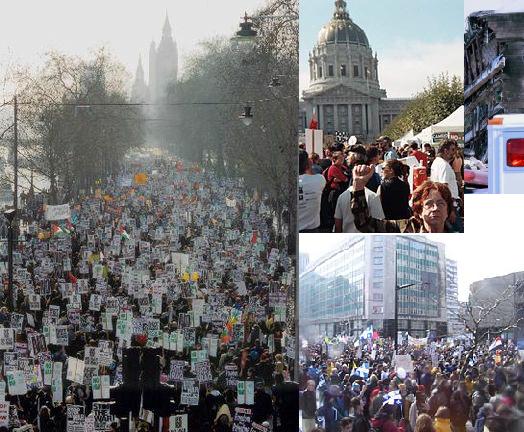
Antiwar Protests in
London, San Francisco and Montreal
 Globally,
the largest of these rallies was
when one million people gathered
at a
rally in London’s Hyde Park on
Feb. 15, 2003. Demos numbering
100,000 or more
were seen in many cities in Europe
and the United States, with
smaller ones even
to the village level throughout
the world. I recall being part of
a march in San
Francisco numbering upwards of
50,000 early that year. The parade
here was led
by the trade union
contingent from the waterfront up
Market Street to the Civic
Center. I was in the front row of
the march in the center holding
the banner of the
Alameda County Central Labor
Council as a WWII veteran, flanked
by two husky
Vietnam vets marching on either
side of me. It was clear to us
that the majority of
the American people were against
military engagement with Iraq with
hundreds of
thousands on the streets
throughout the country sending a
powerful message to
Bush of NO WAR! When the media
pointed all of
this out to the President, he
simply dismissed them as the work
of “special interest groups.” Globally,
the largest of these rallies was
when one million people gathered
at a
rally in London’s Hyde Park on
Feb. 15, 2003. Demos numbering
100,000 or more
were seen in many cities in Europe
and the United States, with
smaller ones even
to the village level throughout
the world. I recall being part of
a march in San
Francisco numbering upwards of
50,000 early that year. The parade
here was led
by the trade union
contingent from the waterfront up
Market Street to the Civic
Center. I was in the front row of
the march in the center holding
the banner of the
Alameda County Central Labor
Council as a WWII veteran, flanked
by two husky
Vietnam vets marching on either
side of me. It was clear to us
that the majority of
the American people were against
military engagement with Iraq with
hundreds of
thousands on the streets
throughout the country sending a
powerful message to
Bush of NO WAR! When the media
pointed all of
this out to the President, he
simply dismissed them as the work
of “special interest groups.”
Bush
Attacks!
|
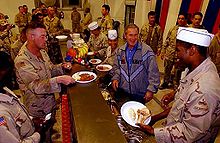
|
|
W
Bush-in-Iraq-photo op
|
 On March
19, 2003. the dogs of war were
unleashed against Iraq by Bush and
his
UK and Aussie allies. The military
phase ended very quickly as their
troops
toppled the Saddam regime, not for
Iraqi’s “freedom,” but to secure
the control of
its oil for the unimpeded profits
of world capital, as historian
Kevin Phillips points
out in the 2006 paperback edition
of his book “American Theocracy.”
According
to Phillips, Bush expected the oil
wells of Iraq to almost
immediately pump
unlimited amounts of the black
gold for the free flow of profit
for Western
capitalist coffers. He was wrong
as continuous insurgent rebellion
and sabotage
diminished instead of
freed the flow of oil for years.
It was no loss to capture the
tyrannical Saddam Hussein from a
hole in the earth and condemned to
death and
executed by a corrupt puppet
government that succeeded his
rule. He had plenty of
blood on his own hands. (Phillips
also indicated that Bush had
another reason
beside the oil to invade Iraq. A
devout evangelistic Christian,
Bush at times
intimated he had been chosen by
God to “liberate” Iraq from its
unholy bondage,
which he would publicly deny.)
Iraq is hardly a
liberated country to this day.
It’s
had its share of corrupt
governments and civil war, whether
Shiite or Sunni. US
imperialist intervention has made
things worse than better there. At
this writing in
early 2017, another desert civil
war is going on between
an always corrupt central
government, armed and advised by
the USA, and another fanatically
religious
group called Isis which uses
beheadings as a device for
conformity, including
those of some Westerners. The only
area of Iraq that appears to have a
stable civil
society is the Kurdish north. In
addition, Syria is in the mire of
war now as well. On March
19, 2003. the dogs of war were
unleashed against Iraq by Bush and
his
UK and Aussie allies. The military
phase ended very quickly as their
troops
toppled the Saddam regime, not for
Iraqi’s “freedom,” but to secure
the control of
its oil for the unimpeded profits
of world capital, as historian
Kevin Phillips points
out in the 2006 paperback edition
of his book “American Theocracy.”
According
to Phillips, Bush expected the oil
wells of Iraq to almost
immediately pump
unlimited amounts of the black
gold for the free flow of profit
for Western
capitalist coffers. He was wrong
as continuous insurgent rebellion
and sabotage
diminished instead of
freed the flow of oil for years.
It was no loss to capture the
tyrannical Saddam Hussein from a
hole in the earth and condemned to
death and
executed by a corrupt puppet
government that succeeded his
rule. He had plenty of
blood on his own hands. (Phillips
also indicated that Bush had
another reason
beside the oil to invade Iraq. A
devout evangelistic Christian,
Bush at times
intimated he had been chosen by
God to “liberate” Iraq from its
unholy bondage,
which he would publicly deny.)
Iraq is hardly a
liberated country to this day.
It’s
had its share of corrupt
governments and civil war, whether
Shiite or Sunni. US
imperialist intervention has made
things worse than better there. At
this writing in
early 2017, another desert civil
war is going on between
an always corrupt central
government, armed and advised by
the USA, and another fanatically
religious
group called Isis which uses
beheadings as a device for
conformity, including
those of some Westerners. The only
area of Iraq that appears to have a
stable civil
society is the Kurdish north. In
addition, Syria is in the mire of
war now as well.
Conclusion
of 2003
SUMMER IN
KALLIO
 The Summer
of 2003 saw me living in the
traditional old working class
district of
Kallio in Helsinki. Usually when I
lived in Finland during the summer
months I
stayed in the likewise
cosmopolitan city of Tampere, two
hours north by train from
the capital. But this
summer my old retired psychiatrist
friend Paula Erkkila from
the Guerneville, CA environs
rented a large partially furnished
one-bedroom flat
in Kallio and invited me to spend
the summer with her and kick in
for part of her
rent. Paula occupied the bedroom
and I a couch in the living room,
since we
weren’t lovers. The arrangement
worked very well as we both had
our own daily
agendas. We both did our own
cooking or ate out. Breakfasts
were at home,
lunches out, and dinners both
ways. I often ate lunches at
the Helsinki University
or downtown cafeterias. Usually I
did calisthenics and yoga first
thing in the
morning before breakfast. Then off
to the Kallio branch public
library to read
newspapers and use the computer.
Then I either walked, bicycled, or bussed
downtown where I’d hang out in the
main library, bookstores and parks
or
rendezvous with friends. The
headquarters of the Finnish Free
Thinkers’
organization was a hangout as well
as the anarchist bookstore where
I’d meet
comrades. Weekends I’d see my
Helsinki cousins or old friends
like my old
Finnish-American
comrade Bill Hellberg and his wife
Arja. Bill spent his time
translating Helsinki University
Finnish language textbooks into
English as a living
then. The Summer
of 2003 saw me living in the
traditional old working class
district of
Kallio in Helsinki. Usually when I
lived in Finland during the summer
months I
stayed in the likewise
cosmopolitan city of Tampere, two
hours north by train from
the capital. But this
summer my old retired psychiatrist
friend Paula Erkkila from
the Guerneville, CA environs
rented a large partially furnished
one-bedroom flat
in Kallio and invited me to spend
the summer with her and kick in
for part of her
rent. Paula occupied the bedroom
and I a couch in the living room,
since we
weren’t lovers. The arrangement
worked very well as we both had
our own daily
agendas. We both did our own
cooking or ate out. Breakfasts
were at home,
lunches out, and dinners both
ways. I often ate lunches at
the Helsinki University
or downtown cafeterias. Usually I
did calisthenics and yoga first
thing in the
morning before breakfast. Then off
to the Kallio branch public
library to read
newspapers and use the computer.
Then I either walked, bicycled, or bussed
downtown where I’d hang out in the
main library, bookstores and parks
or
rendezvous with friends. The
headquarters of the Finnish Free
Thinkers’
organization was a hangout as well
as the anarchist bookstore where
I’d meet
comrades. Weekends I’d see my
Helsinki cousins or old friends
like my old
Finnish-American
comrade Bill Hellberg and his wife
Arja. Bill spent his time
translating Helsinki University
Finnish language textbooks into
English as a living
then.
 I traveled
around Finland to see my cousins in
Oulu and Kemijärvi.
Frequently I’d
go to cities all over the country
to see track and field meets
called the Elite Games
(Eliitti
Kisat) where
the country’s top athletes would
compete. I attended the
National Championships on seven
different seasons
called Kaleva Games
(Kalevan
Kisat), the
highlight of my Finnish summers. I traveled
around Finland to see my cousins in
Oulu and Kemijärvi.
Frequently I’d
go to cities all over the country
to see track and field meets
called the Elite Games
(Eliitti
Kisat) where
the country’s top athletes would
compete. I attended the
National Championships on seven
different seasons
called Kaleva Games
(Kalevan
Kisat), the
highlight of my Finnish summers.
FORSSA
LEFT ALLIANCE PARTY CONVENTION
The Social
Democratic Party of Finland was
founded in Forssa, Finland in
1903,
strongly influenced by the German
Marxism of Karl Kautsky and August
Bebel.
Its history from the beginning
with its rapid growth was based on
pragmatic
reforms popular with the Finnish
working class. Nationalization of
basic industry
stayed mostly on the theoretical
drawing board for some time in the
far future
which never seemed to arrive. (An
outstanding example of public
ownership,
however, is the State Railway
System (Valtion
Rautatie)). So 2003
marked the
100th anniversary of the SDP. But
in that 100 years there were
several political
splits in the political labor
movement. Today the SDP is still
the largest party, has
led the government several times
and adopted the market economy
as a given
under the more recent leadership
of Paavo Lipponen, a former Prime
Minister. The
Left Alliance Party is a few steps
to the left of the SDP and
champions democratic
values and is more strongly
critical of the capitalist West
than the SDP and
considers itself Red/Green
politically. . At present (2017)
LA holds 12
Parliamentary seats and is led by
a 29-year-old woman
MP, Li Andersson from
Turku, as national chairperson.
The third labor party is the
Communist Party of
Finland which is a shadow of
its former self during the Post-WWII
period when it
was strongly influential in a
broader left party, the SKDL,
(Finnish Peoples’
Democratic League), a predecessor
to the Left Alliance. The
Communist Party has
no MPs in Parliament but does have a couple
of city council members in
Helsinki
and Tampere. A smaller communist
party, Finnish Communist Workers
Party, is a
tiny Marxist sect that supports
the CP government of North Korea
as its political
lodestar.
 There were
celebrations of the 100th anniversary of
the founding of the historic
SDP in Forssa in the summer of
2003 held separately by the SDP,
Left Alliance,
and CP on different weekends.
There obviously was no real
movement toward a
united labor anniversary of that
historic milestone. I definitely
wanted to be at
Forssa for at least one of them. I
chose the Left Alliance’s weekend
as I
considered myself closest to the
LA, although my basic orientation
is anarcho-syndicalist. There were
celebrations of the 100th anniversary of
the founding of the historic
SDP in Forssa in the summer of
2003 held separately by the SDP,
Left Alliance,
and CP on different weekends.
There obviously was no real
movement toward a
united labor anniversary of that
historic milestone. I definitely
wanted to be at
Forssa for at least one of them. I
chose the Left Alliance’s weekend
as I
considered myself closest to the
LA, although my basic orientation
is anarcho-syndicalist.
 It was an
exciting weekend for me at the LA
Convention which consisted of
dramatic skits of its history,
lectures, discussion workshops,
women’s issues
seminars. music, dancing, dinners,
group singing and poetry. I met
and talked to
numerous LA members and supporters
and felt comfortable mixing with
them. My
favorite dinner
companion was Liisa Mutru, a
middle-aged woman
from Helsinki,
who was a marine cook and steward
and a member of the Finnish
Seamen’s
Union. You can be sure I had a
grand time discussing my great
hero of the Finnish
labor movement, Niilo Wälläri, the great leader
of the Seamen’s Union, with her. It was an
exciting weekend for me at the LA
Convention which consisted of
dramatic skits of its history,
lectures, discussion workshops,
women’s issues
seminars. music, dancing, dinners,
group singing and poetry. I met
and talked to
numerous LA members and supporters
and felt comfortable mixing with
them. My
favorite dinner
companion was Liisa Mutru, a
middle-aged woman
from Helsinki,
who was a marine cook and steward
and a member of the Finnish
Seamen’s
Union. You can be sure I had a
grand time discussing my great
hero of the Finnish
labor movement, Niilo Wälläri, the great leader
of the Seamen’s Union, with her.
PARIS
WORLD ATHLETICS CHAMPIONSHIPS

 My summer
was rounded out with my long-planned
visit to Paris to see my first
World Track & Field
Championships in the suburb of St,
Denis at the Stade de
France (Olympic Stadium). All
the top athletes of the world
competed here. I
commuted to the Stade daily from
my hostel in Central Paris on the
Metro to see
my favorite sport. I took a
Finnair flight to Paris and most
of the Finnish team was
on my flight. While waiting to
board, I
chatted with several of its
members. One
was Kenyan-born
Wilson Kirwa, a middle distance
track runner who had won
several Finnish national
championships where I had seen him
compete in the 400,
800, and 1500-meter
distances in Finland. His running
Club was the
Lahden
Ahkera Club of Lahti. Speaking in
perfect Finnish, he said Ahkera
was the most
supportive of Finnish clubs for
African-born
athletes. I also chatted with
Johanna
Halkoaho, who I had seen win
several national championships in
the long jump
and as I
remember the hurdles. During the
off-season the friendly Johanna
was a
school teacher. Unfortunately,
neither Wilson or Johanna made it
out of the
preliminary qualifying rounds at
Paris. The most successful Finnish
athletes were
women’s javelin ace Mikaela
Ingberg who was fourth with 60.89
meters at Paris
and the men’s top spearman Aki
Parviainen who was fifth with
83.05. (Olli-Pekka
Karjalainen, Finland’s record
holder in the hammer (83.30) never
made the finals.)
Sergei Makarov of Russia won the men’s
javelin with 85.44m with his
compatriot
Tatiana Shikolenko the women’s
with 63.79. My summer
was rounded out with my long-planned
visit to Paris to see my first
World Track & Field
Championships in the suburb of St,
Denis at the Stade de
France (Olympic Stadium). All
the top athletes of the world
competed here. I
commuted to the Stade daily from
my hostel in Central Paris on the
Metro to see
my favorite sport. I took a
Finnair flight to Paris and most
of the Finnish team was
on my flight. While waiting to
board, I
chatted with several of its
members. One
was Kenyan-born
Wilson Kirwa, a middle distance
track runner who had won
several Finnish national
championships where I had seen him
compete in the 400,
800, and 1500-meter
distances in Finland. His running
Club was the
Lahden
Ahkera Club of Lahti. Speaking in
perfect Finnish, he said Ahkera
was the most
supportive of Finnish clubs for
African-born
athletes. I also chatted with
Johanna
Halkoaho, who I had seen win
several national championships in
the long jump
and as I
remember the hurdles. During the
off-season the friendly Johanna
was a
school teacher. Unfortunately,
neither Wilson or Johanna made it
out of the
preliminary qualifying rounds at
Paris. The most successful Finnish
athletes were
women’s javelin ace Mikaela
Ingberg who was fourth with 60.89
meters at Paris
and the men’s top spearman Aki
Parviainen who was fifth with
83.05. (Olli-Pekka
Karjalainen, Finland’s record
holder in the hammer (83.30) never
made the finals.)
Sergei Makarov of Russia won the men’s
javelin with 85.44m with his
compatriot
Tatiana Shikolenko the women’s
with 63.79.
 I made a
point to stand out in the streets
of downtown St. Denis to watch the
brunt
of the men’s and women’s 20K
racewalks and the men’s 50K, my
favorite all time
sport in which I had competed
myself in the Masters’ age groups.
Starting and
finishing on the Stade track,
men’s 20K winner was Jefferson
Perez of Equador in
1:17:21 and Yelena Nikolaeva of
Russia was first woman in 1:28:52.
Both were
world record holders at one
time. I have seen Yelena compete
in Finland a couple
of other times. Robert Korzeniowski of
Poland won the men’s 50K in a then
world
record time of 3:36:03. This
concluded a most rewarding
European summer for me
in 2003. I made a
point to stand out in the streets
of downtown St. Denis to watch the
brunt
of the men’s and women’s 20K
racewalks and the men’s 50K, my
favorite all time
sport in which I had competed
myself in the Masters’ age groups.
Starting and
finishing on the Stade track,
men’s 20K winner was Jefferson
Perez of Equador in
1:17:21 and Yelena Nikolaeva of
Russia was first woman in 1:28:52.
Both were
world record holders at one
time. I have seen Yelena compete
in Finland a couple
of other times. Robert Korzeniowski of
Poland won the men’s 50K in a then
world
record time of 3:36:03. This
concluded a most rewarding
European summer for me
in 2003.
Sadly, this
is the concluding installment,
as Harry passed away in El
Cerrito, California
(San Francisco Bay Area) at 9:00
a.m.
Sunday, May 7, 2017.
Solidarity Forever.
|